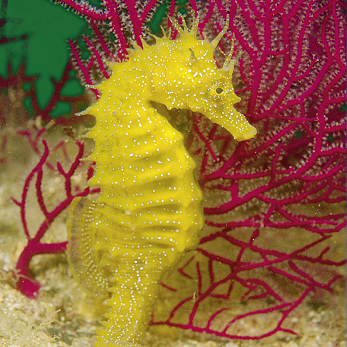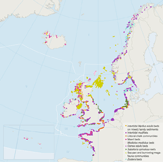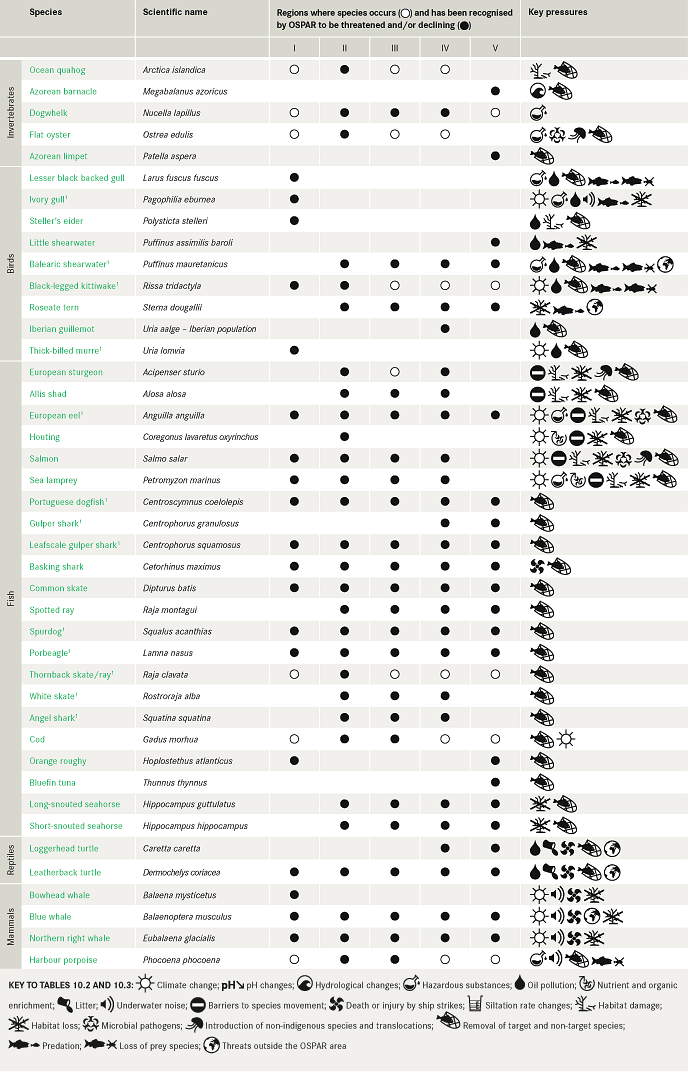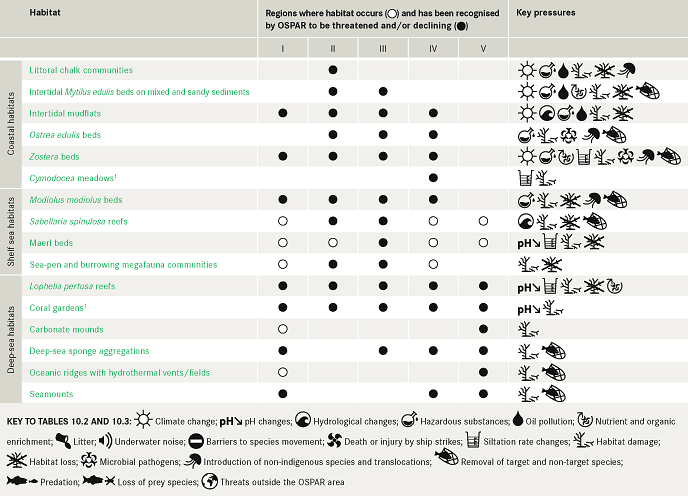Species and habitats under threat and/or in decline
To help set priorities, OSPAR’s work on protection and conservation of biodiversity has started from an identification of those species and habitats most in need of protection. The OSPAR List of threatened and/or declining species and habitats was agreed in 2003 and extended in 2008 Table 10.2 and Table 10.3. It was based on agreed criteria for decline (expressed in terms of population, distribution and condition of species, and distribution, extent and condition of habitats) and threat (expressed in terms of there being a direct or indirect link to human activity). There has been no revision of the list associated with the present quality status assessment (i.e., the QSR 2010). Establishing trends for all species and habitats on the list is challenging, but recent information for some features is presented in the following sections and in the background assessments to this Chapter.
The key pressure affecting the species listed is the removal of target and non-target species, mainly as a result of fishing, while other key pressures include habitat loss or damage, and pollution. Large-scale oceanographic changes associated with climate change, including ocean acidification, rising sea level and increasing sea temperatures, are likely to become increasingly important in the coming decades. Other pressures include the introduction of non-indigenous species and litter. Some species suffer land-based pressures, such as predation at seabird breeding sites and barriers to migration through freshwater areas for those migratory fish species with life stages in both fresh and salt water. The three whale species listed were historically depleted as a result of commercial whaling until the 1960s.
The most important pressures affecting habitats are habitat loss, for example from coastal development or mineral extraction, and habitat damage, in many cases through bottom trawling.
Working to protect species and habitats
OSPAR has been working to identify and implement the best means of protection for these threatened and/or declining species and habitats, many of which are affected by multiple pressures from human activities, often acting cumulatively. Some species and habitats have benefited from improvements in the quality of the marine environment over the past 20 years achieved as a result of OSPAR’s work on eutrophication, hazardous substances, offshore oil and gas production and the phasing out of several types of waste disposal.
OSPAR has collected and mapped available information on the distribution of threatened and/or declining habitats Figure 10.1 and has urged the relevant fisheries authorities to take this information into account in actions to protect these habitats from fisheries-related impacts.
OSPAR has identified a range of actions to be taken to protect particular species and habitats. These include:
- Raising awareness of the species and habitats and their key pressures among stakeholders and wider society.
- Taking into account threatened and/or declining species and habitats in environmental impact assessment processes.
- Supporting improved identification of threatened species (sharks, skates and rays, sturgeon) among key users of the sea (e.g. fishermen).
- Protection of breeding sites (seabirds, including roseate tern and thick-billed murre).
- Restoration of habitats and protection of migration corridors (diadromous fish).
- Reintroduction programmes (European sturgeon).
- Improved coordination of monitoring of species, habitats and pressures, and sharing of information, for example, on sightings (turtles, basking shark).
- Action to reduce by-catch (sharks, skates, rays, Balearic shearwater, harbour porpoise, turtles).
- Establishing marine protected areas (MPAs) to protect important functional areas for species and habitats, including key life stages (shark, skates and rays).
Several other international organisations and frameworks contribute to protection and conservation of marine biodiversity Table 10.1. OSPAR needs to coordinate its work with the efforts of these organisations and to provide a framework to harmonise and support consistent actions at national level. Conservation efforts for many species need to be supported by further research, especially on demographics and life history. Improved mapping of the distribution, extent and condition of seabed habitats is vital to support management. Better coordination of monitoring and information collection is also important.
A network of MPAs is under development
OSPAR is developing an ecologically coherent network of well-managed MPAs for the North-East Atlantic and has set the aim for this to be established by 2010. The network is intended to make a significant contribution to the sustainable use, protection and conservation of marine biodiversity including in areas beyond national jurisdiction. Both the network and the aims set for it add to, and complement, the system of Natura 2000 protected areas for the marine environment established under the EU Birds Directive and the Habitats Directive and other national measures. Specifically, the OSPAR network has extended geographical coverage and the ecologically based criteria used to select OSPAR MPAs are broader than the Natura 2000 criteria and include the need to represent a more extensive range of species and habitats. OSPAR’s aim of an ecologically coherent network seeks to ensure that the MPAs interact with, and support, the wider marine environment as well as other MPAs. This is particularly important for highly mobile species so as to safeguard the critical stages and areas of their lifecycle (such as breeding, nursery and feeding areas). Appropriate management is vital to achieve good ecosystem health and functioning within and outside MPAs. The most appropriate management measures to achieve the objectives of each MPA need to be defined in a management plan. Zoning, seasonal closures, and restrictions on certain activities (e.g. fishing effort management, gear restrictions) are all management approaches that could be employed in MPAs.




